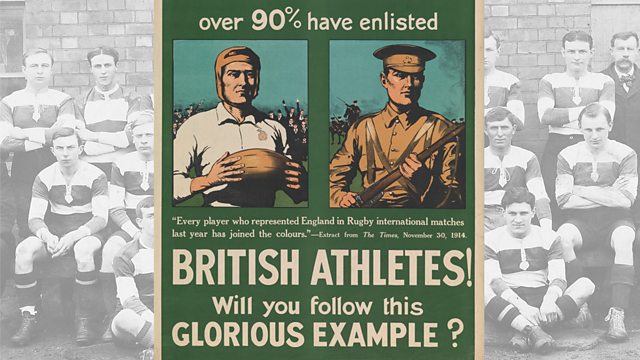Gloucester Rugby Club, Gloucester: Great Players in the Great War
Former Gloucester player Simon Devereux uncovers the the club's role during WW1
Former Gloucester player Simon Devereux uncovers the the club's role during World War One.
The Club had organised a complete and full fixture list for the 1914-15 season and knew which players were returning. The prospect of war took the Gloucester Football Club and its players by surprise and even with the declaration of war there was still an expectation that fixtures would be fulfilled for financial reasons and commitments to other clubs. But a wave of patriotism started to make local clubs re-think their playing schedules.
Players began to volunteer seemingly having no ‘allegiance’ to the fixture list as they rushed to the recruiting stations meaning there was no longer enough players to field a team. On 2 September 1914, Gloucester cancelled all its fixtures and issued a statement:
"…practically the whole of the playing members have enlisted but in any case the Committee would not have felt justified in fulfilling the fixtures even if the players were available owing to the rapid change of the situation in connection with the war."
At a recruitment meeting at Shire Hall on 28 August, Major John Collett called for 25 enlistees to join the local territorial battalion; the 5th Battalion, Gloucestershire Regiment, to bring it up to strength. That day between 300 and 400 men rushed the platform:
“…a tremendous cheer went up when Sid Smart, the Gloucester footballer and English International took his place on the platform and similar demonstrations were accorded to the Captain of the Gloucester football team, [Lionel] Hamblin and his colleagues, Albert Cook and [William] Washbourn.”
The majority of the Gloucester Football Club players joined the 5th Battalion of the Gloucestershire Regiment while some decided on other battalions of the Gloucestershire Regiment, the Worcestershire Regiment, Royal Engineers, Royal Artillery and Royal Navy.
In December 1914, the First Canadian Contingent - newly arrived to Britain - challenged the 5th Gloucesters to a match. Colonel John Henry Collett, OC 5th Gloucesters secured the prestigious Queen’s Club in London – a venue which would have normally been ’out of bounds’ to the common soldier and rugby player alike. The match took place on 12 December 1914, with a crowd of over 700 servicemen from the 5th Gloucesters and the Canadians.
By the end of January 1915 war became ‘serious’ and the Battalion was reorganised into the 4 Company battlefield organisation. The Inter-Company competition had to be re-started, although there was now an urgency surrounding the games. The final played on 6 March 1915 between C and D Companies: D Company emerged victorious by 11 points to nil
On 29 March 1915, the 5th Battalion, Gloucestershire Regiment landed at Boulogne with 5th Gloucesters being transported initially to Steenvorde on the Belgian border. Of the 30 Gloucester players who died in the Great War
Nine men were from the 1913-14 squad (First XV and Gloucester A)
Average Age: 27 years
Eldest: Ronald Grist (47 years)
Youngest: Melville Lewis (20 years)
They died across the war front lines:
Western Front (25)
Burma (1)
Mesopotamia (1)
Salonika (1)
UK (2)
Seventeen of the players have no known grave.
There are memorials mainly in Gloucestershire but also in other areas across Britain which commemorate the names of the rugby players. Their names adorn the Gloucester War Memorial and the 5th Battalion, Gloucestershire Regiment Memorial. Their names are also listed in various churches including All Saints, St Mary de Lode, St Mary de Crypt, St Mark’s, St Lawrence C of E, Upton St Leonards, Highnam, Prior’s Norton, St Mary’s Penzance. They have also been recognised by towns including Cheltenham, Lydney and Newent and at various schools including Sir Thomas Rich’s, the Crypt Grammar and the King’s School.
After World War Two the Gloucester Club purchased land in Tuffley Avenue and created the Memorial Ground as a memorial to the fallen players of both World Wars. The ground was intended to be used by junior clubs and today it is home to Old Cryptians RFC and Widden Old Boys RFC.
Location: Gloucester Rugby Club, Kingsholm Stadium, Kingsholm Road, Gloucester GL1 3AX
Image: In the background; 1913-1914 Gloucester A squad, courtesy of Gloucester Rugby Club, and in the foreground; a recruitment poster encouraging other athletes to follow suit of rugby players during the war, courtesy of IWM
Duration:
This clip is from
Featured in...
![]()
����ý Radio Gloucestershire—World War One At Home
Places in Gloucestershire that tell a story of World War One
![]()
Sport—World War One At Home
The devastating impact on sporting life and the rise of women's football
More clips from World War One At Home
-
![]()
The loss of HMY Iolaire
Duration: 18:52
-
![]()
Scotland, Slamannan and the Argylls
Duration: 07:55
-
![]()
Scotland Museum of Edinburgh mourning dress
Duration: 06:17
-
![]()
Scotland Montrose 'GI Brides'
Duration: 06:41







